project13:Styling
(→Activities) |
|||
| Line 3: | Line 3: | ||
The activities have already been mentioned in the interactions chapter. The diagram is shows in this paragraph as well. Each of these activities needs a different environment. An architectural space that differs in size, materialization, shape, interior, perception, outside connection, routing, etc. But the activities have a lot in common at the same time. They are even better subdivided in some sort of gradient than a strict matrix. Therefore, lots of different spaces are needed. | The activities have already been mentioned in the interactions chapter. The diagram is shows in this paragraph as well. Each of these activities needs a different environment. An architectural space that differs in size, materialization, shape, interior, perception, outside connection, routing, etc. But the activities have a lot in common at the same time. They are even better subdivided in some sort of gradient than a strict matrix. Therefore, lots of different spaces are needed. | ||
| + | [[File:13_steigenga_activities scheme.jpg|450px]] | ||
| + | |||
| + | '''Activities''' | ||
* - Think | * - Think | ||
* - Meditate | * - Meditate | ||
| Line 10: | Line 13: | ||
* - Teach | * - Teach | ||
| − | + | '''Characteristics of Spaces''' | |
| − | + | ||
| − | + | ||
| − | + | ||
| − | + | ||
| − | + | ||
* - Shape | * - Shape | ||
** - Composition | ** - Composition | ||
Revision as of 20:34, 23 September 2012
Contents |
Activities and Space
The activities have already been mentioned in the interactions chapter. The diagram is shows in this paragraph as well. Each of these activities needs a different environment. An architectural space that differs in size, materialization, shape, interior, perception, outside connection, routing, etc. But the activities have a lot in common at the same time. They are even better subdivided in some sort of gradient than a strict matrix. Therefore, lots of different spaces are needed.
Activities
- - Think
- - Meditate
- - Input
- - Output
- - Discuss
- - Teach
Characteristics of Spaces
- - Shape
- - Composition
- - Scale
- - Materialization / Color
- - Interior
- - Objects
- - Lightning
- - Openings
- - Routing / Connectivity
- - History / Character
- - Actors / Figurants
Perception
There exist a lot of different ways an architectural space can interact with people. For this stage of the design process focus has been shifted towards one of them: architectural space. The feeling people have in a church is completely different than, for instance, a classroom. Ignoring the function, materialization and use of color and looking only at the shape and the proportion of dimensions the perception of the two is completely different. How can a space influence a person's behavior, thoughts, feelings, etc.? How is architectural space perceptible?

